
Our final Wordless Wednesday of 2018 takes us back to New York and a view looking west from Manhattan towards Jersey City during a winter sunset.
Please also check out our latest video: Episode 99.


Our final Wordless Wednesday of 2018 takes us back to New York and a view looking west from Manhattan towards Jersey City during a winter sunset.
Please also check out our latest video: Episode 99.
We at CatSynth are admirers of brutalism, as anyone who follows us on Twitter can attest. We love the geometric forms, how it screams “modern”, and how it makes such an intense break with tradition. And I will admit, I also have a little fun using it to poke fun at the architectural conservatism prevalent in places like San Francisco. But above all, it provides a singular beauty to built spaces.
Brutalism perhaps reached its zenith in the former Yugoslavia during the period between the end of World War II and 1980, a period that is highlighted in a current exhibition at the MoMA, Toward a Concrete Utopia: Architecture in Yugoslavia, 1948–1980. It highlights the work of several Yugoslavian architects in the period and pieces ranging from prosaic apartments to public arenas to monuments. The buildings themselves are, of course, not on display in the museum, but their stories are told through models, photographs, and examples of interior objects.
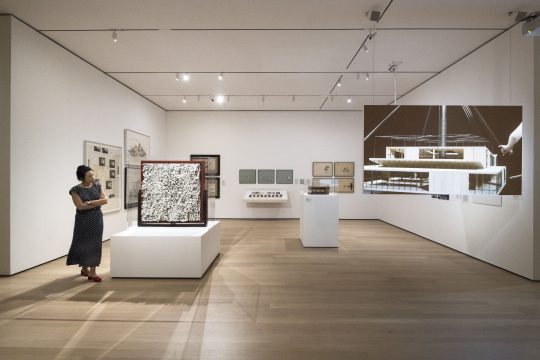
A convergence of factors came together which allowed these modernist experiments to flourish. Yugoslavia broke away from the Soviet bloc in 1948 and began to forge its own socialist path and identity. It constituted itself as six republics in a federation in which traditional regional identities were subordinate to a new and modern whole. At the same time, the country was devastated by World War II and needed massive rebuilding. Finally, new ideas in architecture were emerging along with new materials, notably advances in concrete, steel, and glass allowed a new built environment to take shape.
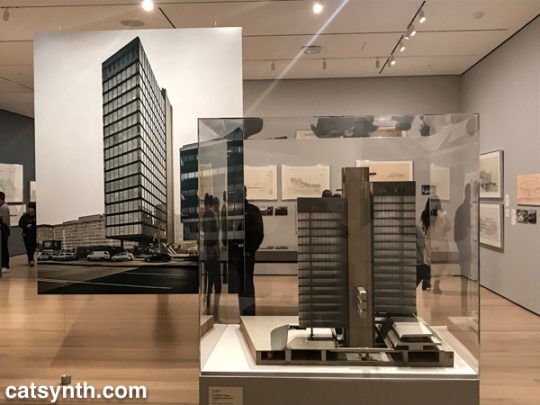
The simple forms and surfaces were used for everyday buildings, such as apartment complexes, schools, and medical facilities. But rather than just one-offs, they become part of a unified cityscape, a grand plan. This was perhaps no more so than in Skopje, the capital of Macedonia, which was devasted by an earthquake in 1963 and largely rebuild using modernist design and principals.
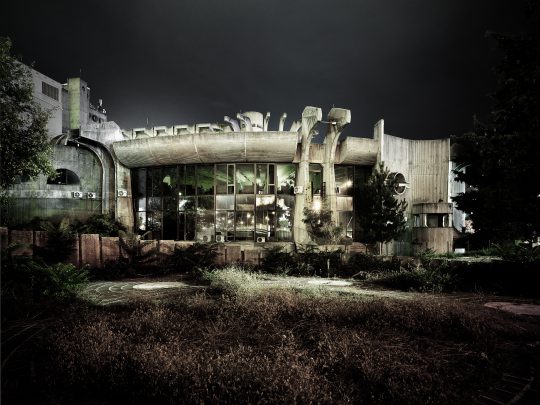
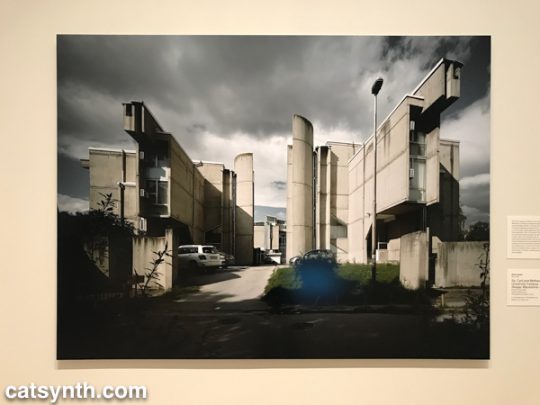
There are, of course, numerous rectilinear designs, sometimes in steel and glass, and sometimes dominated by concrete. But concrete also allowed for the exploration of curved structures and organic shapes. We see this in many of the large civic arenas, but also in the brutalist monuments built in the post-war period. This “cell-like” structure in Macedonia takes it to the extreme, looking at once like an organic organism and a spaceship.
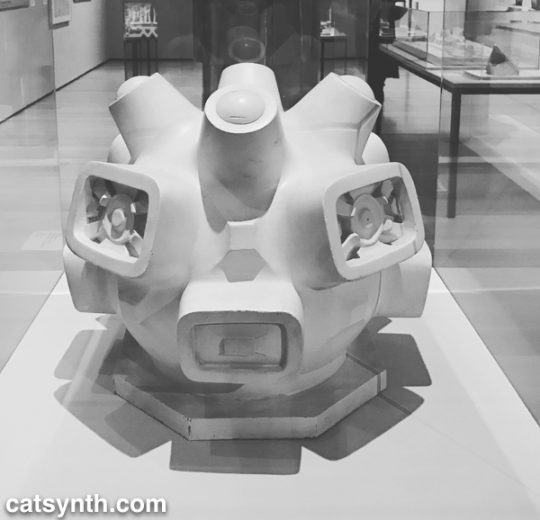
Wandering through the exhibition, one cannot help but imagine being the real spaces. For me, the modernist, severe style brings a sense of calm and welcome that more traditional styles don’t always provide.
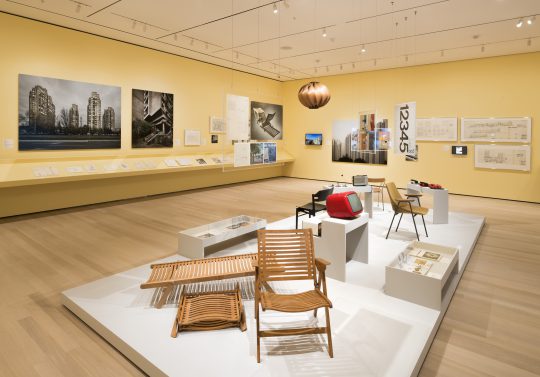
Sadly, the Yugoslavian experiment ultimately failed, with country breaking apart and the entire region plunging into extreme nationalism and devastating wars in the 1990s. This is a cautionary tale as we watch the plague of nationalism rising around the world, including in the United States. Many of the architectural works in this exhibition did survive the wars. But they do face continued challenges to their survival, including maintenance and a push to return to more “traditional” forms. The “Skopje 2014” initiative, for example, is both farcical and tragic. Despite these challenges, I hope the countries of the region will recognize and preserve the legacy of their modernist period for years to come.
This article only scratches the rough, hardened surface of the wealth in this exhibition. It was truly a wonderful experience, even if so much was in my imagination through the artifacts. Toward a Concrete Utopia: Architecture in Yugoslavia, 1948–1980 will be on display at the Museum of Modern Art in New York through January 13, 2019.
The Art of Paper is a multi-artist exhibition currently on display Sundaram Tagore Gallery at their Chelsea location. The term “works on paper” often refers to drawing and print, but the medium and can be used in so many more ways. Each of the artists in the show uses paper in a very different way, showcasing its breadth and versatility as a raw material for art.
Korean artist Chun Kwang Young creates fantastic three-dimensional sculptures from mulberry paper. This thin and delicate paper is prized as an artistic
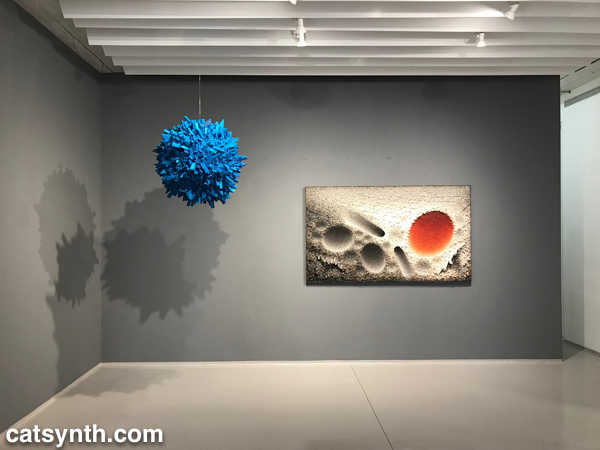
Some are flat and wall-mounted while others are freestanding. But in all cases, they are three-dimensional full of complex depth and texture.
The jagged triangular elements seem sharp, even a bit dangerous up close. But at the same time, they seem fragile, like delicate crystals that could fall apart among touch. When viewing closer, they seem soft, especially as the details of the paper come into view, including the original printed text from the source material. There is something almost science-fiction-y and other-worldly about the result that I find captivating.
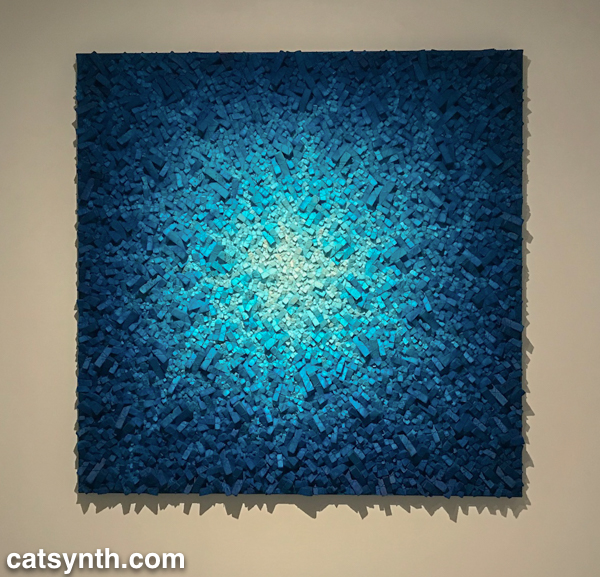
Chun has a simultaneous solo exhibition from his Aggregations at the Brooklyn Museum, which we will be reviewing in a separate article.
The work of Anila Quayyum Agha also uses paper as a basis for sculpture with a very different set of styles, techniques, and sensibilities. She is best known for her works featuring paper laser-cut into large intricate forms. Many of the paper cuts are assembled into cubes placed in immersive spaces with light.
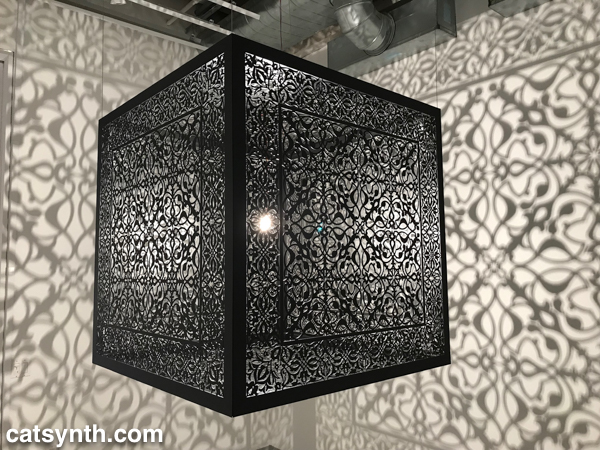
Being in the space of this piece and viewing it from all angles was a captivating experience. It doesn’t seem like paper, but rather intricately carved stone or metal. S
In contrast to Agha’s highly intricate designs, Miya Ando’s work is more subtle and spare. She is known for more abstract work in metal, but she brings that work to paper in her “moonlight” pieces for this show.
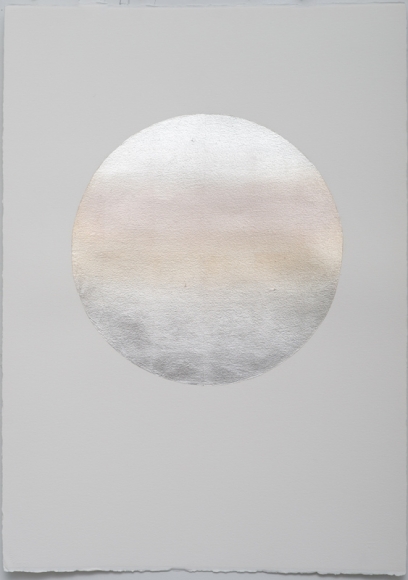
Paper is often white, but it can be many different whites and shades in between those gradations. The subtle changes give the round form a very natural feel in contrast to the stark white background.
There are several more artists in this show, more than we at CatSynth are able to cover in this article. For more information, please visit the gallery’s website. They are located at 547 West 27th Street, and the exhibition will be on display through December 15, 2018.
We at CatSynth took a break from our busy schedule of art, friends, and family in New York to visit the Brooklyn Cat Cafe.
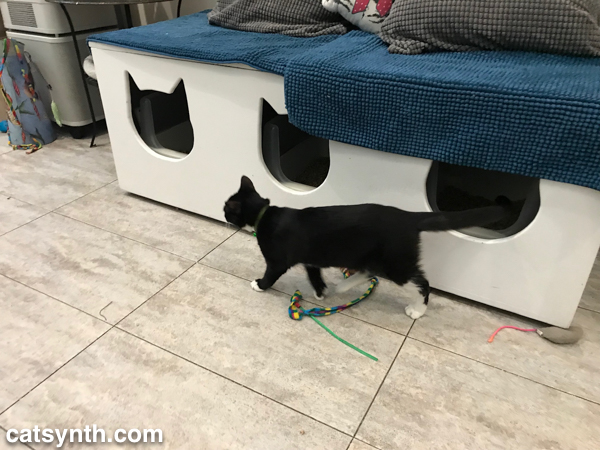
The concept of the “cat cafe” originated in Japan, but has spread around the world, including at least three in New York. Like Cat Town in Oakland, it is an all-volunteer effort focused on finding foster and forever homes for the cats in their care. It is located in a small storefront on Atlantic Avenue in the shadow of the bridges and downtown Brooklyn, but a peek inside reveals a space covered in cats.
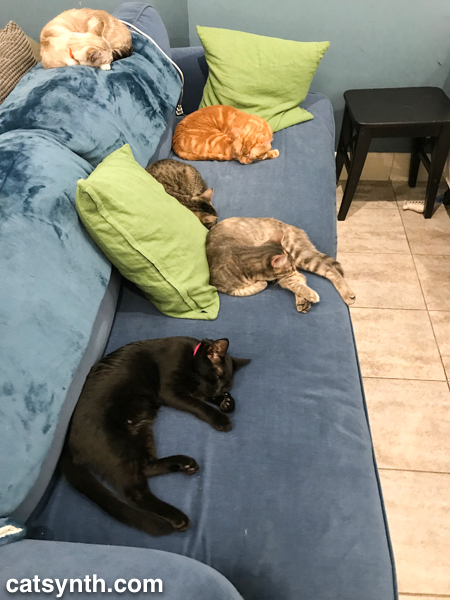
Many were napping, like the line above, but they are also quite playful and affectionate. They are, of course, cats.
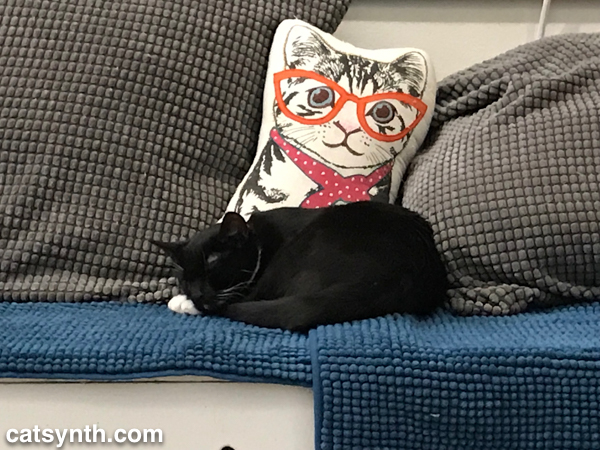
This sweet black kitty greeted me with a nose kisses.
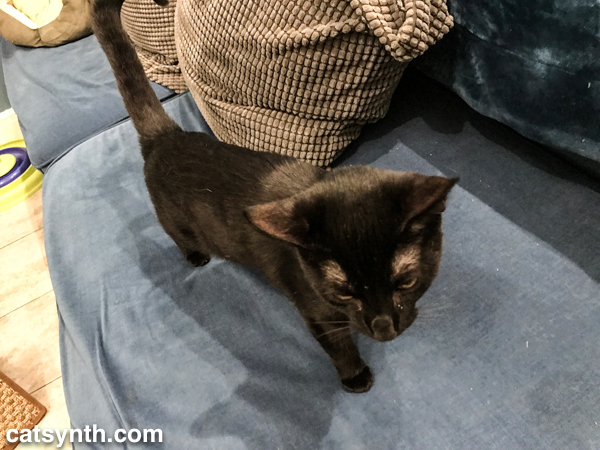
Hilda was perhaps the most playful on this evening, looking visitors in the eyes as she played with various toys. She especially liked this wires dangling from the main table.
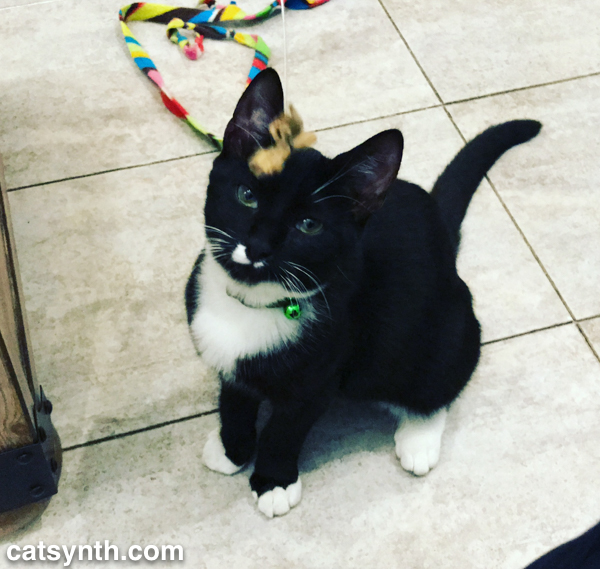
Burton was a big fellow and quite a character. A very friendly cat, he minded me a big of our friend Marlon, aka “the big
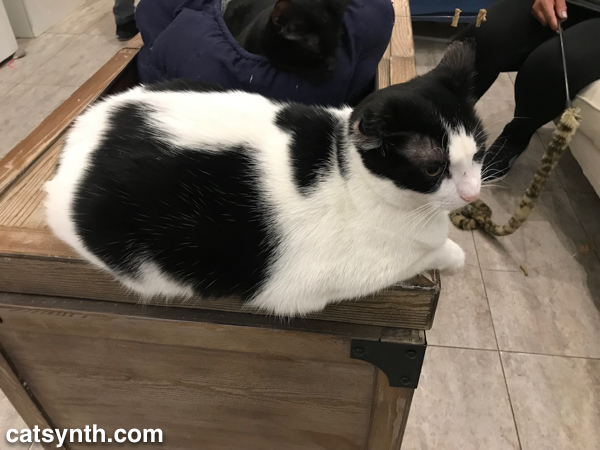
One of the hardest parts of traveling is leaving behind my cats. So having cat cafes is in the cities I visit is most welcome. The change to play with cats, cuddle them, and pet them can brighten the stormiest night.
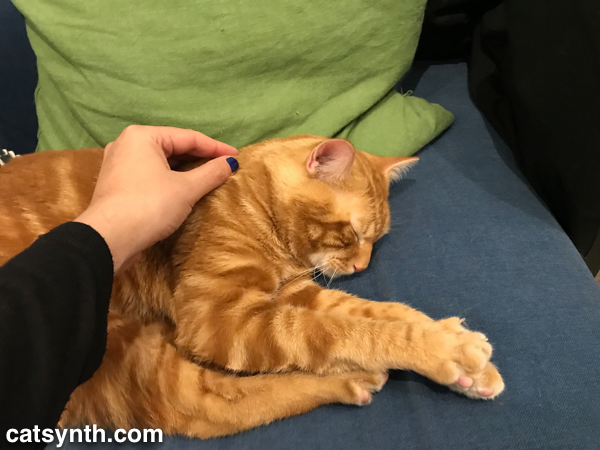
The cats are clearly loved and well cared for, and there are rules for visitors that help ensure a safe and respectful space for them. Most of these fall under the rubric of “don’t be a jerk”, but there are also reminders of the fact that each cat has a different level of comfort with human behavior. If a cat is wary of being pet, respect their boundaries. If a cat needs a break from human interaction and wants to hide (and I can certainly sympathize with that), let them. And the result is a place filled with love among human and feline alike, and many cats have found their forever homes through visits to the cafe.
The Brooklyn Cat Cafe is run by the Brooklyn Bridge Animal Welfare Coalition, which is dedicated to finding homes for cats and other animals in their community. They opened the cafe in 2016.
By our one-year anniversary in May of 2017, the cafe had welcomed over 35,000 visitors — an average of over 95 visitors cuddling with our cats per day — and placed over 250 cats in permanent adoptive homes.
To find out more about the cafe, including visiting, adopting cats, and how to donate or volunteer, please visit their website.
We at CatSynth spent the better portion of a recent afternoon at the Whitney Museum of American Art, taking in the entire museum top to bottom. In the first of our reports, we start at the top with a survey of the work of artist Mary Corse.
The exhibition – Corse’s first solo survey at a major institution – focuses on her work in the mid-to-late 1960s as part of the West Coast Light and Space movement. Like many of her contemporaries, Corse was very interested in the use of light as a medium in itself, but her output of light works was almost entirely focused on flat art, i.e., the kind you can hang on walls. This made her a bit of an outlier in the movement.
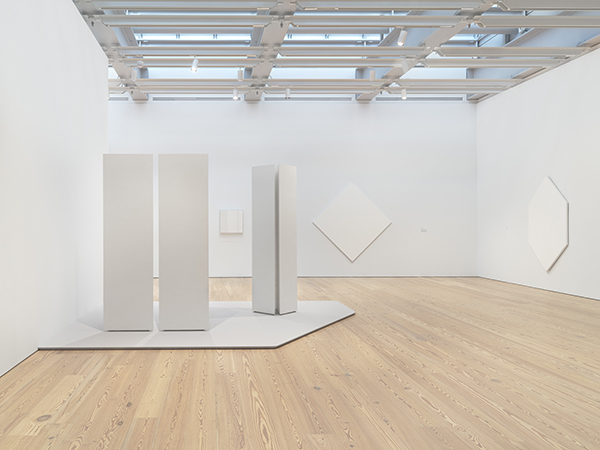
At first glance, it might be tempting to dismiss her work as “another round of white-on-white paintings from the 1960s.” But what makes it interesting is that light is at the center, rather than texture or pigment; and that she delved into emerging technologies and media to move beyond painting.
The most intriguing pieces in the exhibition were those that used plexiglass and lighting technologies. Corse studied physics and engineering in preparation for this body of work. We see this in her series where custom Plexiglass elements of different depths are juxtaposed next to one another allowing different amounts of light to pass through.
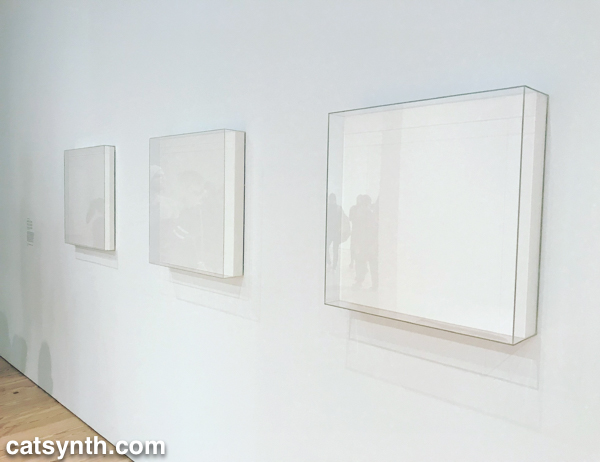
It is a subtle but fascinating set, and I found myself moving back and forth and looking from either side in my own exploration.
Corse also made her own light elements with a variety of technologies, including this piece from 1968 which employed an argon light and frequency generator, once again with her own custom plexiglass. I would have loved to have seen it in
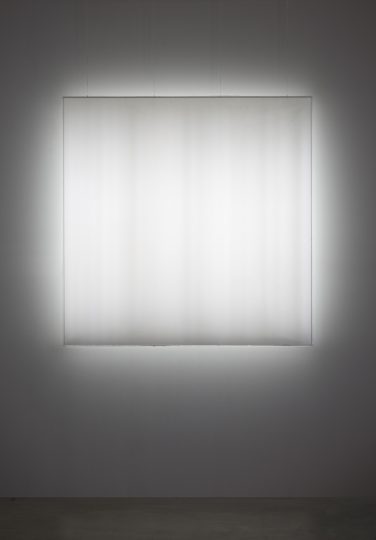
Looking at the bands within the light, I immediately found myself thinking of the amplitudes in a time-varying sound wave, or perhaps a frequency-domain spectrum. It would have been quite interesting to “hear” it.
The final set of work in the exhibition takes an abrupt turn, making the end of this period in Corse’s career. In 1970, she moved from Los Angeles to Topanga Canyon and embarked on her Black Earth Series of paintings.
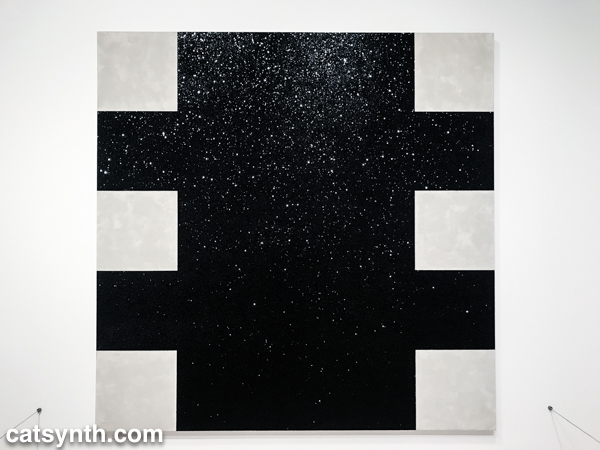
Beyond the obvious switch from white to black, there is a break from technology and a return to working with more traditional materials and textures. The “black” in the Black Earth Series are ceramics made in her own kilns. The glossy material is reflective, but also thick and covered in bumps and curves. This is in stark contrast to the plexiglass surfaces of her earlier work and makes a fitting bookend for the survey.
Unfortunately, the exhibition is closing this weekend, but if you happen to be in New York I recommend checking it out. It makes a fine escape from the overwhelm and sensory overload of holiday season.
Once again, it’s a perfectly clear day this year. Maybe a little haze, but otherwise a blue sky in San Francisco. But the sounds of the city are a bit sharper today, the foot traffic, the construction equipment, the screeching of the commuter rail and light rails pulling into their stations. And there is a bit of wistfulness, a bit of nostalgia in the most classical sense of the word.
A few things have brought 9-11 back to the fore the anniversary. First, there was the opening of the Cortland Street subway station which serves the 1 IRT line and which was pretty much destroyed in the attack. It’s the last major piece of the puzzle in the rebuilding of the neighborhood, which is a thriving and vital space that includes the transit center, the 9/11 Memorial, and of course 1WTC which has taken its proper place in the skyline.
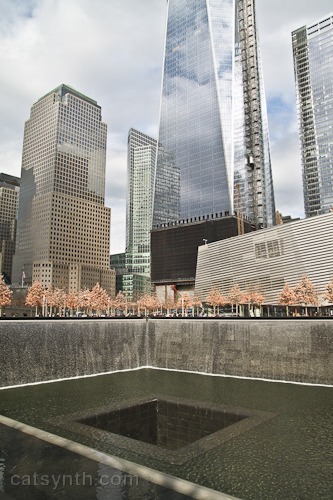
[Photo by CatSynth]
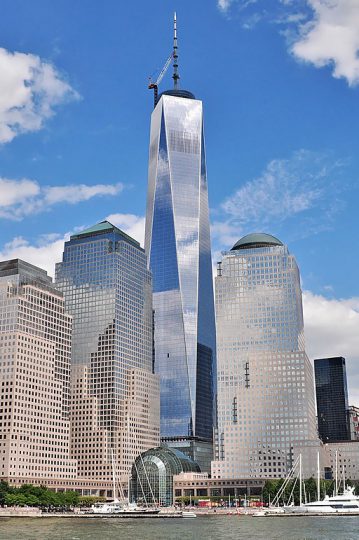
[Joe Mabel (CC BY-SA 2.0 ), via Wikimedia Commons]
Let’s take a moment to emphasize that the building is called 1WTC! It never was, and never will be, the so-called “Freedom Tower”, a name that was obnoxious, jingoistic, and rather gauche. Same thing for the attempts to call the date “Patriot Day”. I always detested that.
The other time bringing today into focus wasn’t 17 years ago, but last year. I was back in New York by coincidence, and the Towers of Light memorial loomed over us in both Manhattan and Brooklyn as we went about simply enjoying being in New York. I posted this picture at the time.
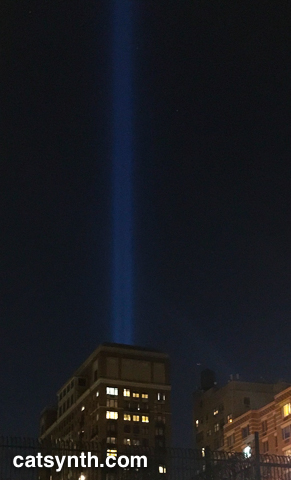
If there is a dominant feeling at the moment, it is more one of homesickness for my home city, the one that will always be The City. And that trip one year ago truly emphasized all its aspect. A wedding on Governors Island with both lower Manhattan and Brooklyn waterfront surrounding us. I rode a record number of subway lines (yes, I’m a total transit nerd). We wandered in Borough Park as well as my usual haunts in Downtown Brooklyn, Chelsea, the West Village, and the Bronx.
17 years ago, the dominant feelings were grief, anger, and (I’m not afraid to admit it) a desire for revenge. That revenge never came – it was twisted by the rest of the country into a nationalistic (and often tacky) morass that turned into multiple wars that left us and the world poorer. The rest of the country rattles its swords, waves its flags, and the great cities suffer. I do hope one day the radical fundamentalism and radical nationalism that grip so many places in the world, including our own country in this moment, will dissipate. And I hope to return home again.